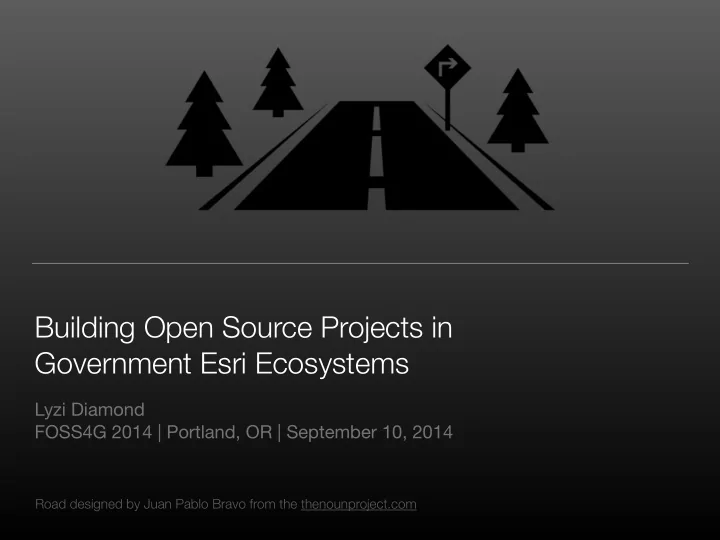

Building Open Source Projects in Government Esri Ecosystems Lyzi Diamond FOSS4G 2014 | Portland, OR | September 10, 2014 Road designed by Juan Pablo Bravo from the thenounproject.com
This talk is about building open source web applications with government GIS data. Trail View Hiker designed by Luis Prado from the thenounproject.com
This is a two-way street.
Every day at Code for America, we work with local governments to build applications that: • use open data from a variety of sources; • are typically constituent-facing web applications; • are manageable by the city; • attack government problems with small, technological solutions; • encourage the civic technology community to stay active; and • are designed to stay updated and sustained.
Esri is clearly the dominant vendor in enterprise GIS. Civic technologists just need to learn how to play nice with it. Address designed by Richard Cordero from the thenounproject.com
So let’s talk about how we can build an open- source web application inside of an Esri technology stack.
STEP ONE: Understand the ecosystem infrastructure.
DISCLAIMER: I am neither a backend developer nor a sysadmin. I just like GIS and maps and open source. Take everything I say with a grain of salt.
ArcGIS for Server or ArcGIS Online
Web applications == web access to data. � � (Plus: open.)
The main idea: Use what you have. DO LESS.
STEP TWO: Identify the data you need for your project.
NOTE: Is the data you want protected? NOTE: Does the data you want have information that can’t be shared in bulk? NOTE: Who owns the data? NOTE: How is the data stored?
STEP THREE: Enable access to the data.
Publish hosted, publicly- accessible layers with Esri tools to enable API access. http://bit.ly/esri-publish
Open data portals, too.
STEP FOUR: Extract, transform, load (celebrate)
Extract.
Transform.
Load.
Repeat.
http://seattlegram.herokuapp.com EXAMPLE #1: Citygram and Spyglass
Citygram: location-based, opt-in text message and email notifications about city services.
Spyglass: ETL layer that pulls data from APIs, conforms data for use in Citygram (to GeoJSON), caches data.
http://open-trails.herokuapp.com EXAMPLE #2: OpenTrails Data Converter
http://opentraildata.org OpenTrails: A data standard for enabling parks to undertake quality digital user experience design.
OpenTrails Converter: A tool for converting trail data (shapefiles) to OpenTrails format.
http://lexington-geocoder.herokuapp.com EXAMPLE #3: Lexington Geocoder
Lexington Geocoder: Uses open parcel data and ElasticSearch to do fuzzy matching on addresses.
You can see many more projects and examples on Code for America’s GitHub: http://github.com/ codeforamerica
Other considerations: � • Hosting applications • Changing infrastructure and data storage • Relationship management
SHAMELESS PLUGS: Code for America Brigades and Maptime chapters can help! � http://codeforamerica.org/brigade http://maptime.io
This talk was about building open source web applications with government GIS data. Trail View Hiker designed by Luis Prado from the thenounproject.com
It is not that difficult, and certainly not impossible. Trail View Hiker designed by Luis Prado from the thenounproject.com
Opening government data is a big deal. � You are a champion. � Keep doing the hard work. � It’s worth it. Trail View Hiker designed by Luis Prado from the thenounproject.com
Thanks! Lyzi Diamond | @lyzidiamond | lyzi@codeforamerica.org Slides: http://bit.ly/lyzi-foss4g � � Come to the Maptime party tonight! Road designed by Juan Pablo Bravo from the thenounproject.com
Recommend
More recommend